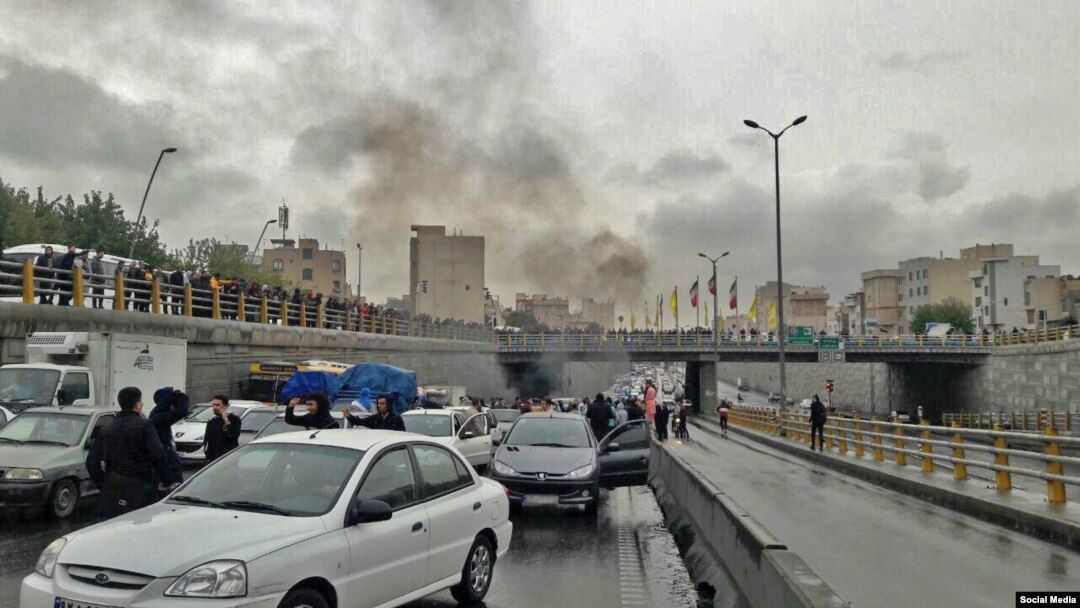One person has been reported killed in sometimes violent protests in Iran over a hike in subsidized gasoline prices that continued into a second day on November 16.
The governor of the city of Sirjan, 800 kilometers southeast of the capital, Tehran, said on November 16 that the demonstrator was killed under unclear circumstances and that several others were injured.
Unconfirmed reports suggested that four other people have been killed in other cities, including in Behbahan, Isfahan, and Marivan.
Mohammad Mahmoudabadi emphasized that "security forces did not have permission to shoot and were only allowed to fire warning shots...which they did."
Your browser doesn’t support HTML5
Iranians Protest Over Hike In Gas Prices
Earlier official reports said some protesters in Sirjan had tried to set fire to an oil depot but were stopped by Iranian security forces on November 15.
Online videos appeared to show fire at the depot, with sirens going off in the area. One video showed a crowd shouting: “Rohani, shame on you! Leave the country alone!”
Clashes between protesters and security forces were reported as well in Mashhad, Ahvaz, and Shiraz.
Demonstrations were reported to have resumed in at least a dozen Iranian cities on November 16. Based on reports by citizen journalists and social media, there have been protests in at least 37 cities across Iran.
In several cities, motorists reportedly blocked roads by turning off car engines.
The demonstrations, while not as widespread as some in the recent past, erupted after the government said it was rationing gasoline purchases and increasing prices as the economy continues to be hit by U.S. sanctions.
The protests could put additional pressure on President Hassan Rohani ahead of parliamentary elections scheduled for February.
Prosecutor-General Mohammad Jafar Montazeri laid the blame for the protests on a "few disruptors" who oppose the system. He warned them that tough action could be taken against them.
Montazeri some are using social media "to provoke" people while claiming that the protests were being guided from outside the country.
Iranians on social media reported receiving threatening text messages by the judiciary warning them not to attend protests. The texts called the protests “illegal” while warning that those attending the rallies could face prosecution.
Internet disruption was also reported in several cities, including Tehran.
NetBlocks, an organization that monitors Internet connectivity, said on November 16 that "Iran is now in the midst of a near-total national Internet shutdown."
"Realtime network data show connectivity at 7% of ordinary levels after twelve hours of progressive network disconnections as public protests continue," Netblocks said on Twitter.
In the holy city of Mashhad, home to the Shi’ite shrine of Imam Reza, dozens of demonstrators stepped out of their vehicles in traffic to protest, IRNA reported.
The protest broke up after police warned demonstrators to leave, the report said.
Elsewhere, videos showed police firing tear gas on crowds in oil-rich Khuzestan Province.
In Ahvaz, hundreds of men and women protesters blocked the road with a sit-in and chanted “We will reclaim our rights but not be oppressed.”
In Tehran, drivers stopped traffic on the Imam Ali Highway, chanting for police to join them, according to online videos.
Meanwhile, two top Shi'ite clerics have criticized the decision for the hike in fuel prices. One of them, Ayatollah Alavi Gorgani, asked the Rohani government to "please reconsider before it's too late!"
After months of rumors, officials on November 14 said a 60-liter monthly limit of gasoline was being set on every private automobile and that prices will go up to about 12.7 U.S. cents a liter from nine cents.
Prices for taxis and ambulances will also be at 12.7 cents a liter for up to 500 liters.
After the quota amount is met, the price will rise to 26 cents a liter.
Iran, which has huge energy reserves, still has some of the lowest fuel prices supported by government subsidies.
However, the country is struggling to meet its domestic fuel needs because of a lack of refining capacity. International sanctions add to the problem by limiting the supply of spare parts to repair and upgrade facilities.
U.S. President Donald Trump last year withdrew from the 2015 nuclear accord Iran signed with world powers, saying the terms were not strict enough to prevent Tehran from developing nuclear weapons. He reinstated sanctions in November that targeted more than 700 Iranian individuals and entities, calling it the "toughest sanctions regime" ever imposed.
Henry Rome, an analyst at the Eurasia Group, told AP that “as in many countries, tinkering with the price of gas is politically explosive.”
“After massive [previous] protests, the Hassan Rohani administration was forced to back down from a 2017 plan to increase prices by 50 percent. The government was clearly attuned to this risk: The latest announcement was made in the middle of the night before a weekend, it took effect immediately, and it was announced without direct consultation with lawmakers.”
Fuel rationing introduced in 2007 under former President Mahmud Ahmadinejad to curb consumption led to anger and violence, including the torching of several gas stations. It was halted in 2015.
Amid the ongoing protests on November 16, U.S. Secretary of State Mike Pompeo said the United States stands with the Iranian people.
"As I said to the people of Iran almost a year and a half ago: The United States is with you," Pompeo said on Twitter.


